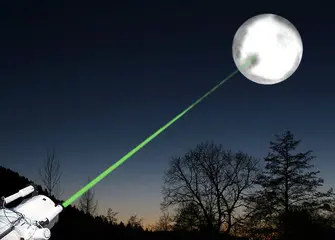Astronomy Lasers for Moon and Stargazing

Looking at the moon and other celestial objects is a source of joy for humans of all ages. There is something delightful and humbling about recognizing humanity’s tiny place on just one of many planets in one of many planetary systems. Telescopes, of course, help amplify our understanding of the moon, planets and other celestial bodies – the magic of seeing something too far for the human eye to understand becomes relatable.
More recently, laser pointers have taken their place alongside telescopes to guide human eyes to see interstellar stuff. Useful as a beam to point out objects in the night sky, astronomy lasers can also be used as a finder scope, a guidance tool for the telescope to find a single star amidst the glowing skyscape. With International Observe the Moon Night coming up on October 16, a few tips on choosing an astronomy laser might help astronomers and students level up their stargazing game.
Choosing an Astronomy Laser Pointer
Because a star laser or laser pointer is pointing at astronomical objects located at a great distance, a laser pointer with a clear, sharp beam is called for. Really, any color of laser pointer will do a fine job of pointing at celestial objects since you will be using it in dark, nighttime conditions. But we are partial to green astronomy laser pointers – more on that below.
For use in astronomy, laser power, no matter which laser color you chose, is not an issue. In general, lower power is preferred for star gazing – around 5 milliwatts is ideal to provide a clearly visible beam while still comfortable for the human eye under normal conditions.
For visible light lasers such as those used for astronomy, a class 3 or 3A laser is the standard. Premium lasers, such as those sold by Alpec, are class 3. Class 3 laser pointers can also be referred to as class 3R.
Also look for a laser offering 100% IR filtration to prevent “ghost lighting” from inadvertently damaging your eyes. This IR filtration along with sealed, tamper-proof laser housing ensure a safe laser experience. All of Alpec’s lasers offer this protection.
Why Use a Green Astronomy Laser Pointer
Even though any color of laser pointer works well for astronomy, green is almost universally the astronomy laser pointer color of choice because of how it interacts with the human eye. (Read more about green laser safety at this link.) Our eyes are more sensitive to the region of the light spectrum in which green resides. The wavelength for green appears very bright, even at low power, approximately 30 times brighter than red, for example. Red, blue or violet lasers require more power to achieve the same level of brightness.
Using a green astronomy laser pointer gives viewers the sensation that the beam is touching the star it is aiming at – there will be no doubt at what object you are pointing –and it is bright enough to work effectively in light-polluted or moonlit skies. Visitors who stop by your telescope setup will be as amazed by the laser pointer as the images in the eyepiece.
For astronomy, choose any color laser pointer you like. But our recommendation is to go green.
This post originally appeared on October 12, 2021
